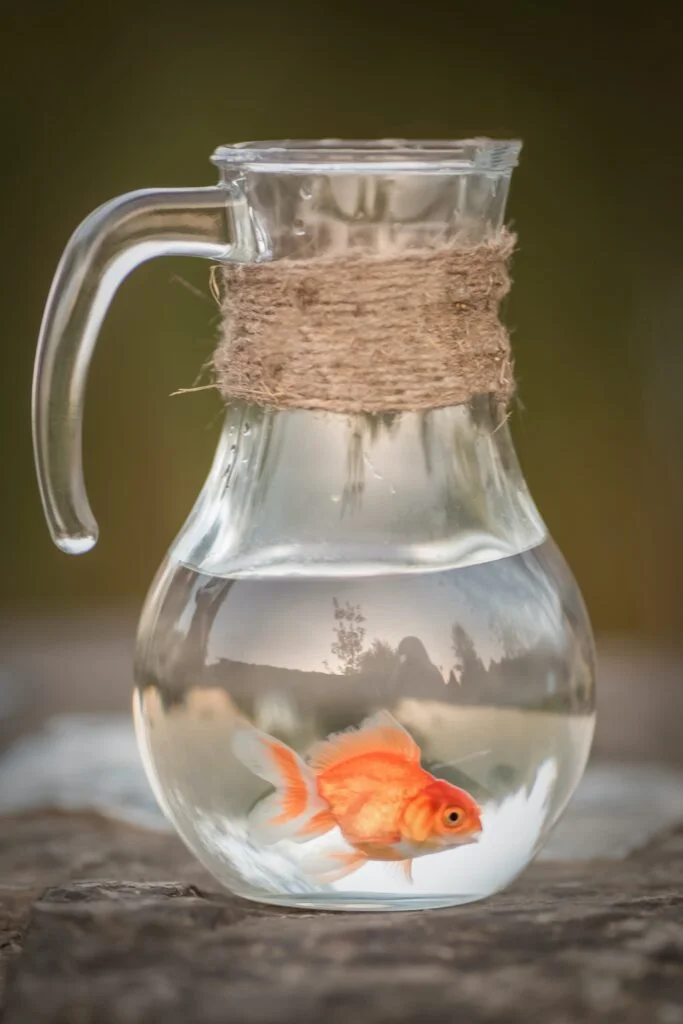If you’re a regular reader of my blog, you might have noticed that I always emphasize the importance of aquarium size in the fish care guides that I write.
And my general rule is that the larger the aquarium, the better.
And I do that for a reason.
Fish aren’t designed to be caged up in a tiny fishbowl!
When looking and observing fish in their natural habitat, whether they reside in small freshwater lakes and ponds or large seas, there is always bigger space for them to move around and carry out their natural behaviors such as foraging for food and mating.
I’m not saying that you shouldn’t get a pet fish (I’m a proud fishkeeper hobbyist for 15 years and have taken good care of my fish over the years).
What I’m saying is that putting your pet fish in a small tiny bowl that doesn’t leave much space for it to move around and without any water filtration is simply killing it.
There used to be a trend before when small fishbowls with small goldfish were popular.
People will usually buy them just from the roadside or at their local retail stores and keep them in their houses where they die after two-three days.
They might think they’ve got scammed but no, (technically yes), if you don’t have enough knowledge and don’t know much about fishkeeping, water filtration, pH and accumulated toxins and wastes, and how they affect the fish you shouldn’t buy one.
Now I don’t want to turn this post into a personal rant, but I’ve always gotten a little excited when I talk about aquariums.
So, to make this post more informational and hopefully educational, let’s know some of the common malpractice in fishkeeping that cause your fish to suddenly die without exhibiting any signs of illnesses, and learn why your pet fish deserve a large aquarium.
Fish aren’t fit for small spaces
If looking at some of the freshwater ponds around the world where we get most of the popular freshwater fish right now, you will notice that they are pretty large.
Not large as a sea but lakes will be more than 200 acres on average while ponds will be less than that.
Here is a picture I’ve taken of my local lake area that houses different fish species.

Bigger than a fishbowl, right?
And this is us not mentioning the saltwater fish environment! No fishbowl or aquarium could imitate that.
Tank size and Ichthyologists
Ichthyology is a science that has been around since 335BC-80 AD. And ichthyologists have studied fish since the beginning before fishkeeping become popular.
And after fishkeeping become popular which was about 1500 years ago (or way before that according to some resources) and have always included in their research and books a section about an ideal tank size for every fish they discovered.
They did that based on observing the natural habitat of the fish and how much space they move in. Very considerate right?
But one thing that they have agreed upon is that the larger the aquarium and the more decorated to imitate their natural habitat -the better.

Fish in a water cup
There is always this idea that you could fit a goldfish in a cup of water. While that’s technically true, it’s killing it.
Fishkeeping isn’t easy and it isn’t hard either, it’s all about your attitude toward it.
If you are earnest about fishkeeping, you would find time to get educated and do some research before planning which fish to get or which tank to buy.
The motive

You wouldn’t want to buy a fish cause you have had an antique vase laying around in the house since World War II and thought it will be a good idea to get a small fish and some plants so you could use it and enhance your house décor. (I know someone who did this!)
If you are planning to enter the hobby of fishkeeping you should first have a noble motive (cliché right?) and be serious about caring for them.
Of course, parents, relatives, and siblings who buy fish for their children, relatives, and siblings and teach them about fish and ways to care for them are the best.
How Advertisements promote fishbowls
You might have seen ads and billboards about small goldfish in a small fishbowl from companies that manufacture and sell aquariums.
The truth is, some of these companies aren’t even aware of the danger they present by promoting this.
Their marketing teams are well-versed in market research and will design and tailor products, especially for people and market demand.
But are they ichthyologists or fish keepers? Obviously no, they are people who play with data and numbers all year round so you won’t expect them to care about the bad impact this will have on fish. ( This can extend to any other industry)
in 2022 The French company Agrobiothers which sells aquariums and pet food has decided, according to Reuters, to abandon manufacturing small fishbowls that are less than 4 gallons because they kill the fish.
In fact, other Europe countries such as Germany have banned fishbowls completely.
Well, this is a good start at least there are some people who start to care about the welfare of the fish.
Why do tiny bowls kill your fish?
If you are a seasoned fish keeper or have been keeping fish for a long time now, you would have noticed that your fish aren’t fulfilling their expected life expectancy.
You might be wondering why is that and if the fish was sick and died or if something unexpected happened.
The answers actually are very simple, keeping fish in small (or large) aquariums reduces the fish life expectancy greatly. The best place for them is their natural habitat. (That’s why it’s important to try and imitate it)
You might read how a certain fish have a lifespan of 10 years but will die just after 6 years or less of staying in your aquarium. (If you have read my other posts, you would notice how I always mention life expectancy in the wild and in the aquarium)
Fish are very delicate and get stressed easily, and stress is the number one cause of death in fish in addition to other natural causes such as old age, minor diseases outbreak, handling, and bad water conditioning.
And where does stress come from?
Fish are easily prone to stress. They can get stressed if you just change them from one tank to another tank or if you just bought them and put them in your tank. They are that fragile.
And of course, the number one reason for stress is the tank size and environment, if you don’t offer much space for the fish to move around and imitate its environment, clean the water regularly from ammonia and nitrate then your tank will turn toxic and kill the fish.
How to deal with stress?
Knowing how to di-stress your fish and how to handle them correctly is very important (we have covered and will cover more about this topic in other posts).
There are some techniques you could use such as always keeping the water clean, pairing them with peaceful fish, and lowering ammonia and nitrate level in the tank.
And of course, the most important factor is the highlight of this article which is to provide a large aquarium that is decorated to imitate their natural environment.
Fish can happily live in small-sized aquariums
But you might say, my fish have been (and is) living happily in my 10-20 gallon tank without any signs of stress or danger of dying.
I’m not denying that fish can’t live happily in small-sized aquariums or fishbowls if cared for properly.
And of course, you can’t keep a fish that get more than 10 inches in length like the Needle Nose Gar in a fishbowl.
What I’m trying to make sense of is that -the larger the tank the better-.( I’m writing here about the popular half-a-gallon to 3 gallons fishbowls)
Of course, there are some fish that can tolerate hardy environments and live in a small 10-20 gallon aquarium without any problems but that doesn’t mean you could fit a bunch of them in a 3-gallon fishbowl.
There are some fish that you could keep in a fishbowl but not in a tiny 0.5 gallons fishbowl without any filtrations and water change.
Although keeping fish, in general, shorten their lifespan, you at least want to make them happy and feel comfortable to live as long as possible.
Potential use of fishbowl
I know many people,(and I’m one of them) who use tiny fishbowls as a shifter, which means I use them to shift a fish from tank to tank or to temporarily isolate it or when I need to treat it. But I don’t keep them there for a long time. generally for a half day to day. which will have no effect on the fish.
Another genius use of a tiny fishbowl is that when buying new fish from your local store you could get them into your small fishbowl instead of wrapping them in plastic bags.
Conclusion
Then again, fishkeeping is a great hobby and it’s keeping on getting more and more popular all over the world with how many fish farms and dealers we see today.
This popularity is well deserved with the many additional health benefits that fish keepers get by caring for and keeping fish.
There is a whole study in the International Journal of Environmental Research and Public Health on how observing live fish can improve mood and relieve anxiety. And other studies in this regard many.
Fish are very beautiful creatures and caring for them isn’t only doing them good but also benefits us.
You can view it as the beneficial relationship between a clownfish and an anemone, one of them protect while the other provides food. A win-win relationship.
I hope that people will stop putting fish in tiny bowls without any filtration, especially goldfish (the number one victim), and treat them more as living being and not only as ornamental fish that you can put in tiny fish bowls and see die slowly without fulfilling its destined lifespan.
If you have any other opinions or want to express your thoughts, I would be very happy to hear from you in the comments below.
You can also bookmark my website and subscribe to my newsletter to get my free Fishkeeping Weekly Planner and regular helpful fishkeeping tips and tricks in your inbox.
Happy-Fishkeeping and don’t forget to share this article with your friends and family using the icons below:

